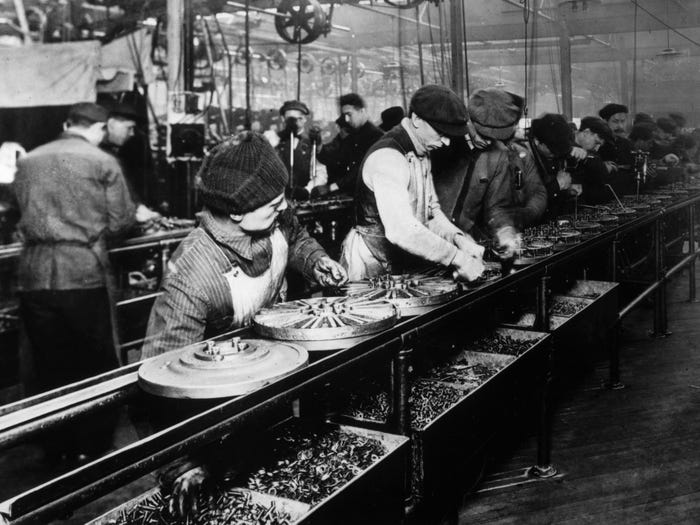Hulton Archive/Getty Images
- Gas-powered automobiles were first invented in Europe in the late 1800s.
- But factories and mass-production techniques soon allowed the US to dominate the car industry.
- Photos from 100 years ago show innovations at factories, and what it was like to work in one.
Germany’s Karl Benz invented the first gas-powered car with a combustion engine in 1885, and he began selling it soon after. In the first decade of the 20th century, manufacturers turned their focus to creating vehicles that were cheaper to make and sell.
Henry Ford established the Ford Motor Company in Detroit, Michigan, in 1903 and, amid demand for his vehicle, the Model T, he innovated new production techniques, specifically the first moving assembly line for cars in 1913. In the early 20th century, other car manufacturers, such as General Motors and Chrysler, also set up shop in Michigan.
Now, the automotive industry is at a crossroads once again as the United Auto Workers Union, or the UAW, launched a historic strike against three Detroit automakers, Ford, General Motors, and Stellantis, in September. The union is putting pressure on the industry over issues of wages, worker schedules, and benefits.
These black-and-white photos show how car factories looked over the past century.
.content-lock-lock .hidden {
display: none;
}
In the US, the earliest car manufacturers were metalworkers, blacksmiths, and the makers of bicycles and carriages.
Archive Holdings Inc./Getty Images
Source: Smithsonian National Museum of American History
In the early 20th century, over 100 companies throughout the country were building small numbers of cars powered by electric, steam, and gas.
Heritage Art/Heritage Images via Getty Images)
Source: Smithsonian National Museum of American History
By 1910, Henry Ford had introduced the next model of his in-demand automobile, the Model T, and William Durant had founded his company, General Motors.
George Rinhart/Corbis via Getty Images
Source: History.com
Henry Ford had big plans for improving how his cars were manufactured, so he constructed a new plant in Highland Park, Michigan, in 1910, helping to establish the state as the industry’s home.
Universal History Archive/Universal Images Group via Getty Images
Source: Ford
At his plant, Ford innovated mass-production techniques with his moving assembly line, which was first used in 1913.
Hulton Archive/Getty Images
Source: Ford, PBS
His innovation was inspired by conveyor belts he’d seen in grain warehouses and assembly lines in slaughterhouses.
Hulton Archive/Getty Images
Source: Ford
The moving assembly line meant the car moved to the employee rather than the other way around. The vehicle was initially pulled into place by a rope — later, a chain — so the car could be built step-by-step.
Hulton Archive/Getty Images
With the moving assembly line, his Model T could be built in only 93 minutes, a dramatic decrease from the 12 hours it previously took.
Underwood Archives/Getty Images
Source: Ford
However, the innovation also made employees’ jobs more repetitive and tedious — like those pictured making flywheels — and they began quitting in droves.
Hulton Archive/Getty Images
So in 1914, Ford doubled wages to $5 per eight-hour day, which is about $150 in today’s money. This competitive wage and its impact on productivity helped the middle class thrive, NPR reported.
Boyer/Roger Viollet via Getty Images
Source: The Henry Ford, Bureau of Labor Statistics, NPR
A shorter workday also allowed Ford to create a third shift, and the plant was able to hire more workers and essentially make the company a 24-hour operation.
Archive Holdings Inc./Getty Images
Source: Ford
By 1926, the Ford Motor Company would become one of the first companies in the US to implement a five-day, 40-hour work week in its factories.
ullstein bild/ullstein bild via Getty Images
Source: History.com
Ford halted production of its Model T in 1927, by which time 15 million units had been sold.
Herbert/Getty Images
Source: History.com
By the 1920s, Ford, Chrysler, and General Motors — all founded in Michigan — would be known as the Big Three automakers.
Hulton Archive/Getty Images
Source: History.com
By 1929, the Big Three were responsible for 80% of the industry’s output.
Frederic Lewis/Getty Images
Source: History.com
By the 1930s, smaller manufacturers were going out of business, unable to keep up with the large-scale production of the Big Three.
Keystone-France/Getty Images
Source: Smithsonian National Museum of American History
Photos from the 1930s show how the production line continued to thrive in America’s car factories. That decade, European car makers adopted the same processes.
Welgos/Getty Images
Source: History.com
More than 6 million women stepped up in response to the shortage of male labor during World War II. In the car industry, the population of female employees increased from 28,300 in October 1941 to 203,300 by November 1943.
CORBIS/Corbis via Getty Images
Source: The University of Michigan-Dearborn
Here, workers are putting the finishing touches on the 1947 models of the Mercury, one of three cars made by Ford at the time, at the River Rouge Complex in Dearborn, Michigan.
Keystone Features/Hulton Archive/Getty Images
Ford workers in Dearborn are photographed finishing the Custom Deluxe at the end of the assembly line, which could produce 500 cars in a single, eight-hour shift.
FPG/Archive Photos/Getty Images
Source: Getty Images
In 1955, General Motors, Chrysler, American Motors (Nash-Hudson), Ford, and Studebaker-Packard were making 99.7% of all cars.
Jerry Cooke/Getty Images
Source: The Saturday Evening Post
